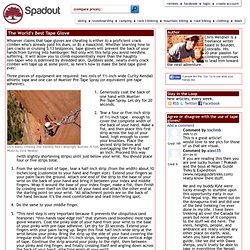

Training to Become a Better Climber - Part 1. More Articles Like This Is it possible to improve your climbing without even trying?

Jack Geldard thinks that a few small changes in your climbing... [ full article ] Top British Boulderer, Ned Feehally shares his experiences climbing some hard boulders both in the UK and the world, his opinions... [ full article ] In this short video from Canadian competition climber Sean McColl, we see Sean training at a private wall in Chamonix, France. ... [ full article ] Popular Articles Right Now Finger Injuries are almost certainly the most common injuries climbers face.
With junior competitions becoming more popular, training for young climbers is becoming much more popular. Related UKC Forum discussions This is the first of a series of training articles and is aimed at beginners or people who are operating in the low grades and wish to improve (Approximate grade range of around UK Diff - Severe, Sport grade F3 - 4 or bouldering grade VB / UK Tech 4c).
Name: Tommy Toprope Footwork – The Basics. How to Build a Campus Board. A campus board, or training board, will drastically improve your finger and forearm strength.

Training on a campus board will give you the most benefit for "bouldering" and short power moves that often become the crux of a "difficulty route". If you need to improve your power and strength, isolate muscles in your forearms, fingers and upper body, a campus board may be just the thing. Construction is relatively easy, and the typical ceiling height is usually sufficient. Rock Climbing Training Guide. Begin and complete the task or tasks within the one minute intervals.

Use the remaining time to rest. Hang a watch from the bottom of the board or mount a wall clock so that you can look straight at it while training. Entry Level: Intermediate: Advanced: Warning All Training Board Users: Training on a hangboard carries risk of injury to fingers, arms, shoulders and the joints connecting them. The Worlds Best Tape Glove - Spadout.com. The World's Best Tape Glove Whoever claims that tape gloves are cheating is either A) a proficient crack climber who’s already paid his dues, or B) a masochist.

Whether learning how to jam cracks or cruising 5.13 testpieces, tape gloves will prevent the back of your hands from turning into hamburger. Not only will this help you avoid needless suffering, it will allow you to climb exponentially more than the haughty non-taper who is sidelined by shredded skin. Quibbles aside, nearly every crack climber will tape up at some point, so here’s how to make the best tape glove ever: Three pieces of equipment are required: two rolls of 1½-inch wide Curity-Kendall athletic tape and one can of Mueller Pre-Tape Spray (or equivalent pre-tape adhesive). Chris Bailey climbing Zion National Park's Moonlight Buttress (5.12d). Wilderness Sports Training and Conditioning Info and Coaching. 10 Rock Climbing Tips and Techniques. Climbing Anchors. All anchors whether they are for belaying, top roping, or rappelling should adhere to the concept of S.R.E.N.E.

Strong: Good anchor systems are built off of solid components, such as a good bolt, stout tree or immobile boulder. Redundant: Anchor systems must be constructed of multiple components so that if any one component fails, the anchor will not fail. Equalized: Building an anchor system so that the load is shared by all of the components decreases the chance that any one component will fail. No Extension: If a component does fail, the anchor system should be constructed so that the remaining components are not shock loaded. Using cord or webbing you can connect anchors together to equalize them and create redundancy, but also they are useful to adjust the length and position of the system so that the rope is not rubbing across the rock. Intuitively you might think that two anchor points will split the load 50/50 in an anchor system. Consider the diagram at left. Rock Climbing Knots - Alpine Butterfly Knot @ ABC-of-Rock Climbing. Rock Climbing Info, News, Pictures, Forum, Shop, Travel and Community.
Thin Jamming. Is that a thumbs-down or an OK sign?

Steph Davis jamming Johnny Cat (5.11d), Indian Creek, Utah. By Steph Davis (from Climbing Magazine, Issue #177, June 1998) The crack above you runs forever. You reach and sink your hand up to the wrist, again and again, plugging cams at will. You're a hero. Unfortunately, offwidth doesn't only mean wide cracks. But before we get into that mysterious sizes, let's talk about sinker hand cracks again. Thin Hands A thin-hand jam is one thin which your hands won't go in deeply enough to get that perfect thumb-in-palm lock. In a typical splitter crack I lead with my left hand because that feels comfortable to me, but you might do the opposite. The true stabilizers in a thin-hand crack are your feet. Ratchets Ratchets are the size down from thin hands, and the next step up in difficulty.
To climb pure ratchets, put both hands in thumbs down. Again, the key to success is in your feet. Ringlocks The size down from a ratchet is the dreaded ringlock. Knots. Eric Hörst's Training For Climbing. Climbing Dictionary.